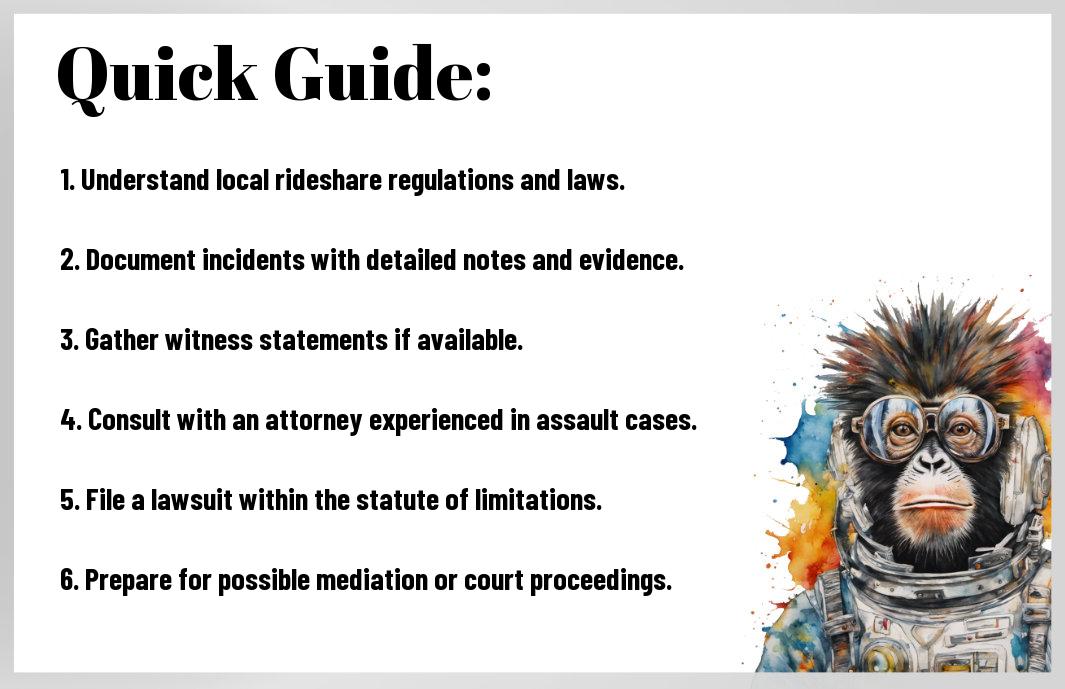Rideshare services have transformed how you travel, but they also present serious risks, including the potential for sexual assault. Understanding your legal options and rights can empower you to take action if you find yourself in such a situation. This comprehensive 5-step guide will walk you through the necessary steps to navigate rideshare sexual assault lawsuits, ensuring you are well-equipped to seek justice. From gathering evidence to filing a claim, each step is vital in addressing these incidents effectively.
Understanding Rideshare Sexual Assault
While rideshare services offer convenience and accessibility, they can also unfortunately become platforms for sexual assault incidents. It is crucial for you to understand the dynamics of these situations, examining both the perpetrator’s and victim’s experiences to navigate this troubling issue effectively.
Types of Rideshare Sexual Assault
While rideshare sexual assault may encompass various actions, here are common types you should be aware of:
- Physical assault
- Verbal harassment
- Unwanted touching
- Sexual coercion
- Rideshare driver misconduct
Perceiving these incidents accurately is vital in understanding the broader implications of rideshare safety.
| Type of Assault | Description |
| Physical Assault | Violent acts causing bodily harm. |
| Verbal Harassment | Unwanted and aggressive comments towards a victim. |
| Unwanted Touching | Inappropriate physical contact without consent. |
| Sexual Coercion | Forcing someone into unwanted sexual acts. |
Legal Standing and Responsibilities
Now, understanding the legal standing and responsibilities involved in rideshare sexual assault cases is critical. As a passenger, you have rights that protect you from such violations, and rideshare companies have obligations to maintain a safe environment.
Rideshare companies are liable for ensuring passenger safety and must conduct background checks on their drivers. If an incident occurs, you can seek legal recourse against the driver and the rideshare company depending on the circumstances. Familiarizing yourself with local laws and reporting procedures will empower you to take appropriate action when necessary.
Step-by-Step Guide to Filing a Lawsuit
One of the first steps in addressing a rideshare sexual assault is to understand the legal process for filing a lawsuit. This guide will break down the vital steps you need to take.
| Step | Description |
|---|---|
| 1 | Contact Authorities |
| 2 | Seek Medical Attention |
| 3 | Consult with a Lawyer |
| 4 | File a Police Report |
| 5 | Draft Your Lawsuit |
Initial Steps to Take After an Incident
On the unfortunate event of an assault, your safety and well-being should be your top priority. Alert law enforcement immediately to report the incident and seek medical attention right away. These actions not only secure your health but also set the foundation for your case.
Gathering Evidence and Documentation
While it may be difficult to think about collecting evidence during an emotionally overwhelming time, it’s vital to document every detail related to the incident. Start by keeping notes of what happened, including dates, times, locations, and any individuals involved. Additionally, preserve any physical evidence, such as clothing or personal items, and gather witness statements if available.
Filing a lawsuit requires comprehensive preparation, and gathering evidence plays a significant role in supporting your claim. Collect photographs, videos, texts, or any social media communications that relate to the event. These pieces of documentation can strengthen your case and provide critical context for your experience. The more thorough you are in gathering this information, the better equipped your legal team will be in presenting a compelling case on your behalf.
Factors Influencing Your Lawsuit
It is necessary to understand the factors that can significantly impact the outcome of your rideshare sexual assault lawsuit. These include:
- The nature of the incident
- The jurisdiction where the incident occurred
- Evidence and documentation you can provide
- The rideshare company’s policies and their accountability
- Time limits for filing your lawsuit
The Uber/Lyft Rideshare Sexual Assault Lawsuit process will depend on these factors and how well you prepare your case.
Jurisdiction and Local Laws
If you are pursuing a lawsuit, the jurisdiction and local laws where the incident took place will play a significant role in your legal strategy. Different states have various statutes and regulations governing rideshare cases, impacting the process, requirements, and potential payouts.
Evidence of Negligence
On a successful claim, you must establish negligence. This means demonstrating that the rideshare company or driver failed in their duties, directly leading to your situation.
For instance, if a driver had a documented history of unsafe behavior or if the rideshare company neglected proper background checks, this evidence of negligence can bolster your case. Keeping records of your ride, communicating with the company, and gathering witness statements will be vital steps in building a compelling argument to support your claim.
Tips for Navigating the Legal Process
Now that you’re familiar with the basics of rideshare sexual assault lawsuits, navigating the legal process can be smoother with these tips:
- Document every detail of the incident.
- Keep a record of all communications related to your case.
- Stay in touch with your attorney regularly.
- Prepare yourself for possibly lengthy legal proceedings.
The legal process requires diligence and patience.
Hiring the Right Attorney
You must choose an attorney experienced in handling rideshare sexual assault cases. Their expertise will guide you through the complexities of the legal system and advocate on your behalf during negotiations and court proceedings.
Understanding the Timeline
Timeline considerations are imperative when pursuing your case. The process can often unfold over several steps, including investigation, filing, and potential settlement or trial.
Understanding the timeline helps set your expectations. Initially, the investigation phase can take a few weeks, followed by filing notices and paperwork. Once your case is underway, it may progress to discovery, where both sides exchange information. Depending on various factors, including the complexity of the case and the court’s schedule, resolution could take months to years. Awareness of each step can help you remain focused and prepared throughout the process.
Pros and Cons of Filing a Lawsuit
To effectively weigh the decision to file a lawsuit after a rideshare sexual assault, it’s necessary to consider both the advantages and disadvantages. The following table outlines these aspects:
| Pros | Cons |
|---|---|
| Potential financial compensation | High legal fees |
| Holding the responsible parties accountable | Emotional toll of the legal process |
| Public awareness of the issue | Lengthy process |
| Possibility of a settlement | Risk of counterclaims |
| Establishing a legal precedent | Uncertain outcome |
Potential Benefits
The benefits of filing a lawsuit can be significant, as they may provide you with both financial restitution and a sense of justice. Successfully pursuing legal action may allow you to claim damages for medical expenses, lost wages, and emotional trauma resulting from the assault. Additionally, your case can shine a light on the severity of the issue, potentially prompting changes within rideshare companies to improve safety measures.
Risks and Challenges
You should be prepared for various risks and challenges when considering a lawsuit. The legal process can be lengthy and complex, which might contribute to increased stress during an already difficult time.
A common challenge you may face includes the potential for high legal fees, which can add financial pressure. Additionally, lawsuits can bring up painful emotions as you recount your experiences in detail, and the process can take months or even years to resolve. You might also encounter the possibility of counterclaims from the rideshare company or its representatives, which could complicate your case and affect your emotional well-being. Understanding these risks is necessary to making an informed decision.

Conclusion
Taking this into account, understanding the legal landscape surrounding rideshare sexual assault lawsuits is vital for you to protect your rights and pursue justice. By following the comprehensive 5-step guide, you can navigate the complex process more effectively. This empowers you to make informed decisions, seek appropriate legal representation, and hold the responsible parties accountable. Your journey to recovery and accountability starts with awareness and action.


















